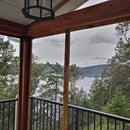Introduction: Getting a Motorcycle Aboard a Sailboat
I have a 32ft sailboat. For years I have taken bicycles aboard to use while cruising. When I got a motorcycle, I thought I'd try to take that along instead
Step 1: Setup
Getting bicycles aboard is trivial - just pick them up in one hand and step aboard. The motorcycle weighs 250lbs, and I can't do that. Even with both hands. I had thought about slings and winches etc - the sailboat comes with a boom, mast, lots of rope etc. - but it is not as easy as it looks, particularly single-handed. You really need one person to work the winch, and one person to guide the load, and the boom is in the wrong place (over the cockpit - OK for removing the boat engine but not where I want a motorcycle). Using a ramp was the obvious answer.
I had a piece of C-section steel beam I had rescued from scrap, which I had used to load the bike into a van. It's easily strong enough, light enough to pick up, and nicely fits the bike tire. The edges are over an inch high and prevent the bike from slipping off sideways.
To use this on the boat, first I need to remove the safety lines. They are designed to easily unclip on the starboard bow (the bit shown in the photo). Then I adjust the dock lines to pull the bow against the dock and hold it securely (usually closer than shown here). The ramp rests on the coaming (wood rail) and is secured with a rope to a deck fitting. This stops it sliding off with the bike's weight on it. It needs to be lined up with a clear space behind to get the bike on. Well, actually, it doesn't, but it's easier that way.
Step 2: Driving Aboard
When everything is lined up properly, start the bike and drive it quickly up the ramp, stepping smartly aboard while holding it upright.
I secure the bike to the port side shrouds, and cover it with a tarpaulin to keep spray off. In heavy seas this area can get very wet, and salt water is not good for bikes. I have not had the motorcycle aboard in these conditions but I used to keep a bicycle there and it was seriously degraded by the experience. Now I keep it across the stern, but that's not an option for the motorcycle (unless I built a special rack for it).
Step 3: Unloading the Bike
Getting the bike off is a matter of reversing the steps in getting it aboard.
Set up the ramp, and lift the back wheel of the bike onto the top of the ramp, making sure the front wheel is lined up properly. Put the bike in first gear, and hold it on the clutch and front brake. Slowly let the brake/clutch off until the front wheel onto the ramp. Step smartly backwards onto the dock, allowing the bike to roll down the ramp.
The photo is actually taken from the getting aboard video, but shows the start point with the back wheel on the ramp.
I had originally fastened a spinnaker halyard to the handlebars in case I dropped the bike. That's a rope that goes to the top of the mast. The whole operation turned out easier than I had originally thought, and this safety rope is not necessary. I might still use it if I was unable to get the bow against a dock - the idea was that the rope would prevent the bike sinking if it fell in the water, or at least enable me to pull it out more easily. But with a regular dock there is no chance of that as the gap is too small.
If you have someone to help, I'm not sure that it would be a good idea to let them - they might get hurt. It's easier to use the bike engine to drive it aboard than to push it. With 3 strong guys, maybe you could just pick the thing up safely.













